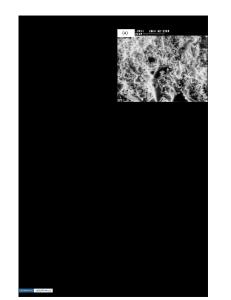Mechanism of 1:1 nonstoichiometric short-range ordering in La-doped Pb(Mg 1/3 Nb 2/3 )O 3 relaxor ferroelectrics
- PDF / 473,839 Bytes
- 11 Pages / 612 x 792 pts (letter) Page_size
- 10 Downloads / 270 Views
MATERIALS RESEARCH
Welcome
Comments
Help
Mechanism of 1:1 nonstoichiometric short-range ordering in La-doped Pb(Mg1/3 Nb2/3 )O3 relaxor ferroelectrics Kyu-Mann Lee, Hyun M. Jang,a) and Woo-Jin Park Department of Materials Science and Engineering, and Laboratory for Physical Chemistry of Dielectric Materials, Pohang University of Science and Technology (POSTECH), Pohang 790-784, Republic of Korea (Received 31 August 1996; accepted 12 November 1996)
The mechanism of the 1:1 nonstoichiometric short-range ordering in donor-doped Pb(B01/3 B002/3 )O3 -type relaxor perovskites was examined using the La2 O3 -doped Pb(Mg1/3 Nb2/3 )O3 (PMN) system as a typical example. Based on the dielectric analysis and the transmission electron microscopy (TEM) observation, the observed increase in the degree of diffuse phase transition (DPT) in the presence of La2 O3 was interpreted as the enhancement of the 1:1 nonstoichiometric short-range ordering accompanied with the growth of the negatively charged nanodomains. The mechanism of the defect process responsible for the 1:1 nonstoichiometric short-range ordering was elucidated by analyzing the electrical conductivity of the La-doped PMN system as a function of the partial pressure of oxygen. It was shown that the substitution of La31 ions for Pb21 ions in the A-site sublattice of perovskite PMN produced the positively charged ≤ LaPb sites with a concomitant generation of electrons for the electronic compensation. This expedites the growth of the nonstoichiometrically ordered nanodomains in a disordered matrix.
I. INTRODUCTION
As discussed in a previous paper,1 it is important to systematically study the short-range ordering of the 00 B-site cations in Pb(B01/3 B2/3 )O3 -type perovskites for the understanding of the diffuse phase transition (DPT) characteristics. Extensive studies on the short-range ordering of the B-site cations have been carried out using Pb(Mg1/3 Nb2/3 )O3 (PMN)-based systems as typical ex00 amples of Pb(B01/3 B2/3 )O3 perovskites.2–7 From these studies, it is now established that the enhancement of the degree of DPT in PMN or, more generally, 00 in Pb(B01/3 B2/3 )O3 -type perovskites is caused by the formation of 1:1 short-range ordered microdomains or clusters. Since the global MgyNb ratio in PMN-based systems is 1:2 (as opposed to 1:1 for the ordered microdomains), the enhanced 1:1 micro-ordering of Mg : Nb thus expedites the B-site compositional fluctuation occurring on a nanometer scale. It is now accepted that this microcompositional inhomogeneity is responsible for the 00 0 DPT behavior in Pb(B1/3 B2/3 )O3 -type perovskites.2–5 For this type of ordering, because the B0yB00 (or MgyNb) ratio is 1:1 within the ordered microdomains, strong charge effects will result, where the ordered (B0 -rich) microdomains will have a net negative charge with respect to the disordered (B00 -rich) matrix. This charge a)
Author to whom correspondence should be addressed. J. Mater. Res., Vol. 12, No. 6, Jun 1997
http://journals.cambridge.org
Downloaded: 23 Jun 2014
imbala
Data Loading...











